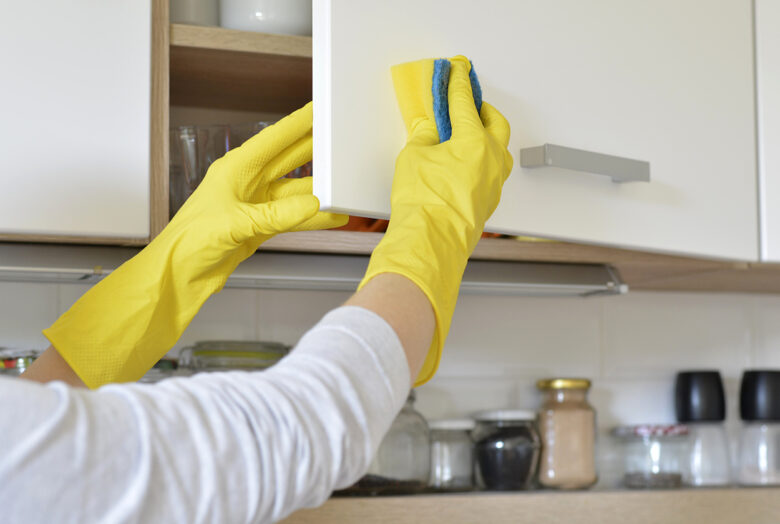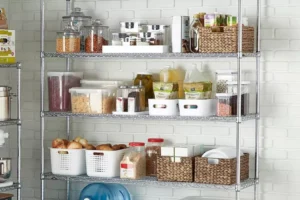Over time, kitchen walls and cabinets can become dirty and grimy from all the cooking that takes place there. This deposit is not only unsightly, but can also affect the quality of your cooking surface if left unchecked. Removing grease from kitchen walls and drawers is not difficult. With the right approach and a few helpful tips, you can easily restore shine and purity. How to do that:
1. Understand How Grease Accumulates:
Before you start cleaning, it’s also important to understand how grease builds up on cooking surfaces. When you cook, especially when you fry, sauté or cook at high temperatures, fat particles are released into the air. Over time, these particles settle on the surface and form a film that sticks to the surface and attracts dirt and dust.
2. Prepare for Cleansing:
Remove items from cabinets and place a protective cloth on counters and appliances to catch any drips of cleaning solution. Gloves can protect your hands from oils and cleaning products.
3. How to Choose the Best Cleaner:
Using the right cleaning products is important to doing a good job. A gentle but effective way to start is by mixing warm water and dish soap. Solutions that contain a degreaser, such as white vinegar, baking soda or mild ammonia, work better with harder grease. Test the cleaner on a small, inconspicuous area first to ensure it will not damage the finish.
4. Cleaning Kitchen Walls:
Mild Cleaning Solution: Mix dish soap and warm water in a bucket. Gently wipe the walls with a soft sponge or cloth, paying particular attention to areas where a lot of grease has accumulated.
Vinegar Solution: You can mix equal parts water and vinegar to create a solution that can remove hard-to-remove grease. Spray it with a spray bottle and wipe with a soft cloth.
Rinse Clean: After cleaning, rinse the wall with clean water to remove any detergent left on the wall. To prevent water spots, dry with a clean, soft towel.
5. Cleaning Kitchen Cabinets:
Dish Soap and Water: Use the mildest option first. You can remove large amounts of grease with dishwashing liquid and warm water. When using a soft cloth or sponge, do not soak the wood too much.
Baking Soda Paste: A paste made from baking soda and water can be used on rough spots. To apply the paste, cover the area with a soft cloth, wipe gently, wash and dry.
Professional Degreasers: There are many professional degreasers that can remove grease from your kitchen. If you decide to do this, follow the product instructions carefully to avoid damage to the tray.
6. Ways to Avoid Problems:
Use an Exhaust Fan: Always use a kitchen exhaust fan when cooking to prevent grease particles from becoming airborne.
Regular Cleaning: To prevent grease buildup, wipe down walls and cabinets as part of your regular cleaning cycle.
Protective Coating: After you have thoroughly cleaned your drawers, you may want to apply a protective coating to them. This preserves the wood and makes it easier to clean later.
Cooking Methods: If possible, choose cooking methods that use less oil, such as frying or steaming.
7. Finally:
Finally, removing grease from kitchen walls and cabinets may seem like a daunting task, but if you have the right tools and methods, it’s not difficult and can make your kitchen look and smell better. To remove grease effectively, follow these tips, including choosing the right cleaning products, such as dish soap, baking soda, or vinegar, and using good techniques such as gentle scrubbing and regular maintenance. Regular, quick cleaning after spills can prevent stubborn grease buildup, making future cleanups easier. Remember, keeping your kitchen clean isn’t just about appearance; it is also good for your health and that of your family. By following these tips, you will keep your kitchen clean and grease-free, so that everyone feels welcome.
FAQs:
1. What is the best cleaning product to remove grease from kitchen walls and cabinets?
A mixture of warm water and dish soap is usually the most effective and gentlest way to remove grease. For more stubborn stains, a solution of equal parts vinegar and water, or a paste of baking soda and water, also works well.
2. Will vinegar damage kitchen cabinets?
Vinegar is generally safe for cleaning kitchen cabinets, especially when diluted with water. However, it is best to test a small, inconspicuous area first to ensure this will not damage the finish, especially on wooden cabinets.
3. How often should I remove grease from kitchen walls and cabinets?
It’s a good idea to wipe down areas where grease can build up, such as above the stove and around the extractor hood, at least once a month. For cabinets and walls that are not frequently used, a thorough cleaning every 3 to 6 months is sufficient.
4. How can I prevent grease buildup on walls and cabinets?
Using an exhaust fan or range hood while cooking can help reduce grease particles in the air. Additionally, covering pots and pans while cooking can reduce splatter, and regular cleaning can prevent grease buildup.
5. Can I use commercial degreasers on kitchen surfaces?
Yes, commercial degreasers can effectively remove large amounts of grease build-up. However, it is important to choose products that are safe for your specific cabinet and wall materials and to follow the manufacturer’s instructions carefully.
6. Do I need to rinse off the cleaning solution after wiping the surface?
Yes, it is generally best to rinse all cleaning solutions with clean water and then dry the surface thoroughly. This helps prevent any residue from attracting more dirt and grease.



